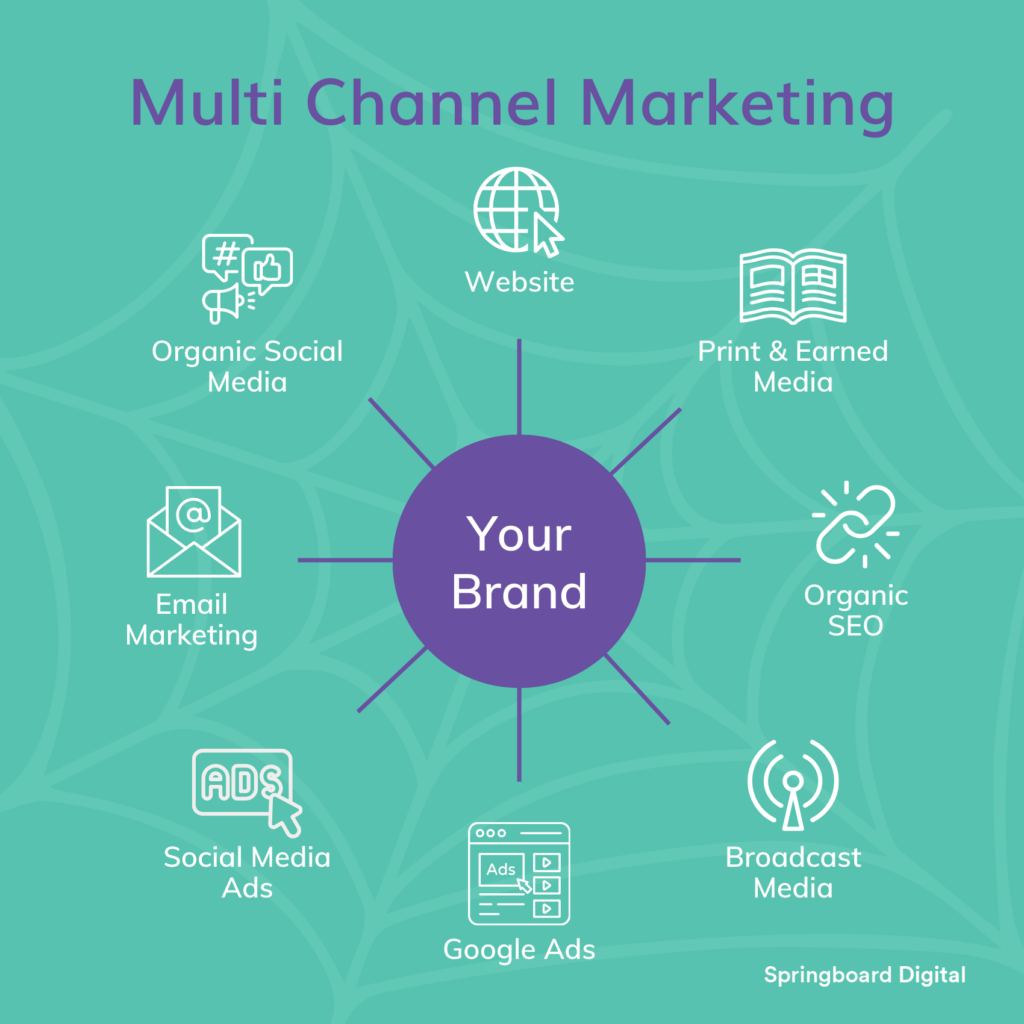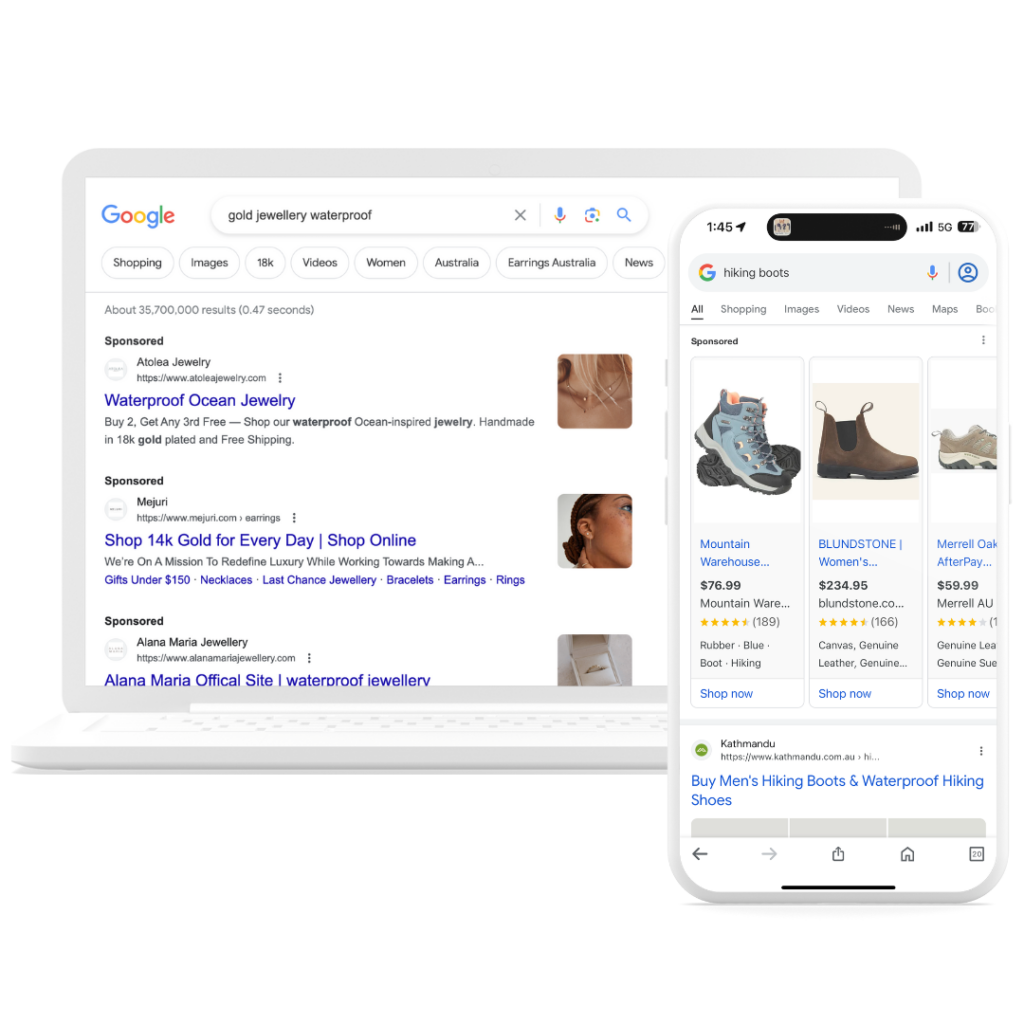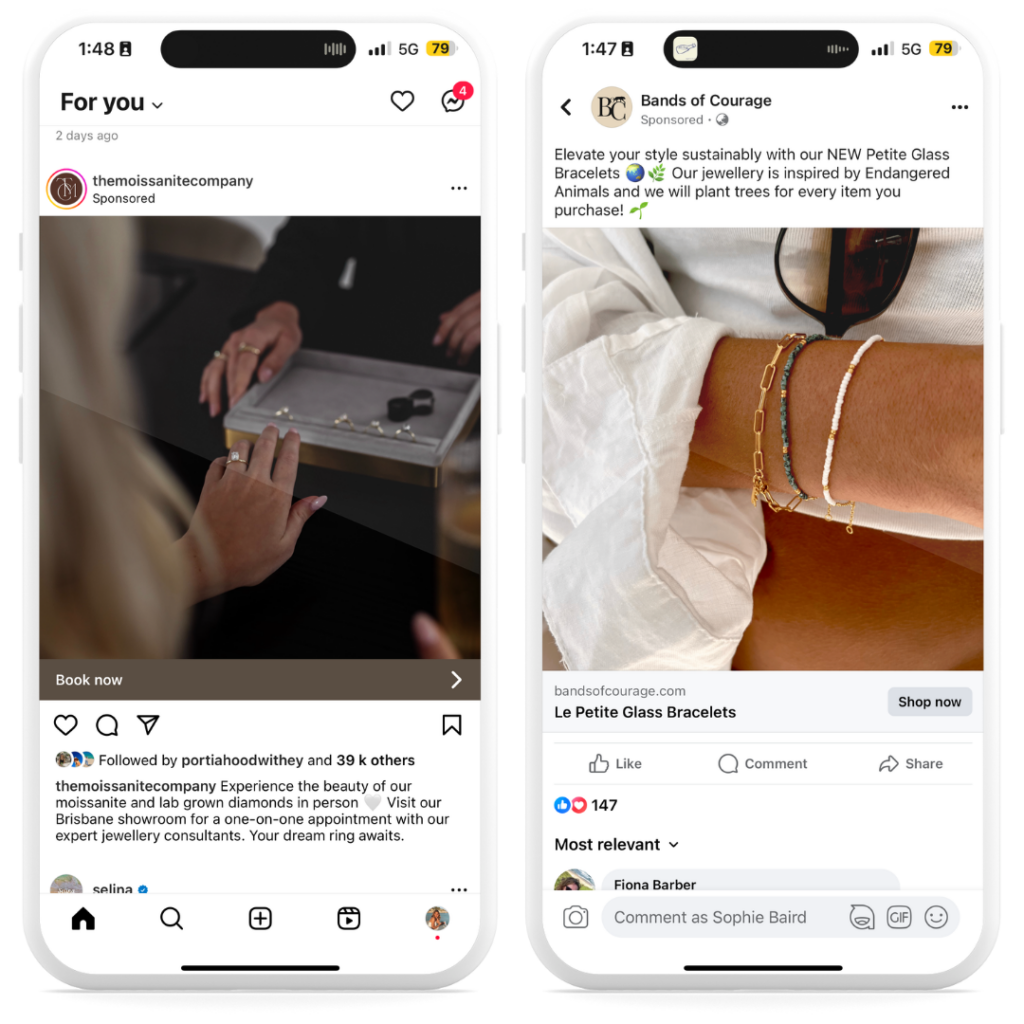Multi channel marketing allows businesses to engage with their target audiences on numerous platforms simultaneously. It’s the best way to get your brand in front of your ideal customer, no matter where they’re spending their time online.
Imagine engaging with your customers through email, search engines, and social media all while maintaining a consistent and personalised message. This strategy not only allows for consistent interaction through all stages of the customer journey, but helps businesses discover new audiences across different platforms and devices (and many more benefits… read on!).

The beauty of multi-channel digital marketing lies in its flexibility and comprehensiveness. For instance, combining Google Ads with advertisements on social media networks allows businesses to reach individuals with specific interests and serve them relevant ads at the right time. It’s like having a conversation with a stranger where you already know what they are likely to be interested in.
We’ll take a closer look at how Google Ads and social media ads work together in today’s article.
Key Takeaways
- Multi channel marketing refers to the practice of reaching customers and promoting products or services through multiple channels or platforms.
- Using paid campaigns on both Google and social media platforms helps businesses reach more audiences and diversify the demographics they are marketing to.
- Using paid ads on multiple channels at once helps increase brand recall, engagement, and conversion potential by leveraging each platform’s unique strengths and audiences.
- For effective multi-channel digital marketing, it’s key to understand your audience, maintain consistency across channels, adopt a data-driven approach, focus on customer experience, and be prepared for ongoing testing and adaptation.
How Do Google Ads Work?
Google Ads come in many forms, but the most traditionally recognisable are the sponsored websites at the top of your Google Search results. Google Ads allow businesses to compete in an auction to have their web pages appear above organic search results for certain queries or “keywords.”
Why? Because more than 90% of website traffic goes to the websites that rank on the first page of Google search results. Of course, getting those top spots is easier said than done.

Google Ads operates on an auction system that takes place in the blink of an eye every time a Google search is performed. During the auction, Google Ads finds all ads with keywords matching the search query and then decides which ads will appear for that specific search and the order in which they will be displayed on the page. This is determined by a combination of factors, including the quality of the ad, the bid, ad rank thresholds, the context of the search query, and more.
The auction process is repeated for every search on Google, leading to varying results with each search depending on the competition at that moment. You can also use Google Ads to promote your business across Google’s other networks, including Google Maps, YouTube, Google Shopping, Gmail, and more. You can learn more about Google Ads and how it works here.
How Do Social Media Ads Work?

Social media ads seamlessly appear as you scroll through your feed and are generally labelled as “promoted” or “sponsored” content. Although it can sometimes feel like your phone is secretly listening to your conversations, the way ads are delivered to your feed is all thanks to sophisticated audience targeting. That’s why, for example, you will have sponsored ads for hiking shoes in your feed if you have recently been browsing for them online.
Marketers use demographics, online behaviours, and interests to ensure ads reach the audiences who are most likely to engage or convert. They can also tailor ad placements and ad format depending on the platform, from image and video ads, to carousels, online forms, polls, and email integrations.
Choosing the right platform is crucial in a strong social media strategy as each offers unique advantages. For example, LinkedIn ads cater to professionals, making them ideal for B2B marketing, while TikTok attracts a predominantly Gen Z audience, perfect for businesses targeting younger demographics. Pinterest focuses on visual discovery so is especially suitable for fashion and home decor, while Facebook and Instagram boast broad user bases.
Of course, it’s crucial to have a strong organic social media presence on any platform before launching paid ad campaigns. Also be sure to keep up with current social media trends, as they’re constantly evolving!
Should You Use Google Ads & Social Media Ads At The Same Time?
Yes, using Google Ads and social media ads at the same time can leverage the performance of the other, therefore increasing the effectiveness of your paid advertising. It’s one of the best ways to improve your digital marketing strategy.
A multi-channel approach helps businesses broaden their reach, increase touchpoints with their audience, and increase the likelihood of engagement and conversions.
Let’s unpack this in a little more detail.
Benefits Of Multi Channel Marketing
Marketing on multiple digital platforms at once offers many benefits:
- Increased Reach: By marketing through multiple channels at once, businesses will reach a much broader audience than if using one channel only.
- Minimises Risk: Just as you shouldn’t put all your eggs all in one basket, you shouldn’t rely on a singular marketing channel – it’s risky. By marketing across numerous platforms businesses can spread the risk, ensuring that if one channel underperforms or faces challenges, others can pick up the slack.
- Diversity: Different user demographics are found on different channels. Multi channel marketing helps businesses tailor their messaging and tactics to each segment’s preferences and behaviours, therefore engaging diverse audience groups more effectively.
- Enhanced Recall and Engagement: If users see your brand across all the digital channels they use, they’re more likely to remember you and take action than if they see a single ad on Facebook.
- Data Insights: Each channel generates its own set of data and insights. By integrating data from multiple channels, businesses can gain a more comprehensive understanding of their customers’ behaviour, preferences, and journey. This can help refine their marketing strategy.
- Synergy and Consistency: Coordinating messaging and branding across multiple channels creates a cohesive brand experience for customers, reinforcing brand identity and messaging at every touchpoint.
- Competitive Advantage: Embracing a multi-channel approach allows businesses to stay competitive in today’s dynamic and rapidly evolving digital landscape, where customers expect a seamless experience across various channels.
Best Practices For Multi-Channel Marketing
There are several best practices to remember to reap maximum benefits from multi-channel marketing.
- Understand Your Target Audience. Gathering market research and website data to create in-depth buyer personas helps businesses understand their target audience. This helps them tailor their marketing strategy and messaging to resonate strongly with the audience, rather than applying blanket tactics that do not inspire action.
- Consistency Is Key. Maintain consistent branding and tone of voice across all channels to avoid customer confusion and increase brand recall.
- Optimise By Channel. Every digital channel has unique strengths, challenges, and audience preferences, so businesses must treat them as such. For example, Google and Pinterest are very different paid media channels that require unique strategies.
- Take A Data-Driven Approach. Data is the key to impactful digital marketing – it unlocks customer insights that enables more accurate targeting and personalisation. Never ignore the numbers.
- Customer Experience. All interactions across channels should be user-friendly and provide value to the customer to enhance brand loyalty. Avoid conflicting messaging that may confuse your customers, such as different sale promotions on different channels.
- Test and Adapt: Multi-channel marketing is not a ‘set-and-forget’ tactic. It requires regular testing, learning, and revising to adapt to consumer behaviour, trends, platform updates, and industry norms.
Let’s Wrap It Up
Simply put, multi channel marketing is a potent method for connecting with your target audience, increasing brand awareness, and inspiring action. Google Ads and paid social media are just two channels you should consider incorporating into your marketing mix if you’re ready to optimise your digital marketing.
Contact Springboard Digital if you want to learn more about how we can help boost your business. Our Client Service Team is already looking forward to hearing from you!
Until next time,
The Digital Marketing Team at Springboard Digital
